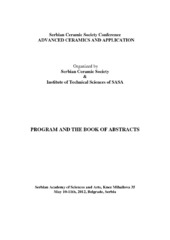Приказ основних података о документу
Kinetics of Mechanically Activated TiO2-based Oxides Followed by DTA
| dc.creator | Obradović, Nina | |
| dc.creator | Pavlović, Vera P. | |
| dc.creator | Filipović, Suzana | |
| dc.creator | Kosanović, Darko | |
| dc.creator | Pavlović, Vladimir B. | |
| dc.date.accessioned | 2017-06-10T15:45:07Z | |
| dc.date.issued | 2012 | |
| dc.identifier.isbn | 9788691562700 | |
| dc.identifier.uri | https://dais.sanu.ac.rs/123456789/524 | |
| dc.description.abstract | TiO2-based materials are widely used in production of ceramic capacitors and semiconductors. The conventional method of ceramics synthesis relies on the solid-state reaction between TiO2 and other compounds (BaCO3, BaO, ZnO, MgO and SrCO3) at high temperatures. During this reaction control of final stoichiometry and powder characteristics are difficult to maintain, because of the lack of the consistency in initial raw material's mixture and the existence of local inhomogeneities in reaction product which occur as a result of incomplete mixing and incomplete reaction of the constituents. In the most cases the sintering kinetics of these ceramics are determined by several parameters, including pressed powder density, material's particle size, sintering temperature, atmosphere etc. As a result, during thermal treatment mass transport by plastic flow, bulk diffusion, surface and volume diffusion, grain boundary diffusion, or a combination of these processes may occur. In order to produce nanocrystalline powders and improve the sintering kinetics, high energy mechanical activation can be employed among other methods. DTA analyses indicated that the position of DTA exothermic peak assigned to the process of ceramics formation was shifted toward lower temperatures in activated samples. The distinction in that peak magnitude due to activation process was observed as well. These results pointed out an increase of the solid state reaction rate, due to activation process. It was concluded that mechanical activation provoked the acceleration of mass transport and enhanced the nucleation probability of a new phase, which caused the decrease of synthesis reaction temperature. | en |
| dc.format | (2012) 24-24 | |
| dc.format | application/pdf | |
| dc.language | en | |
| dc.publisher | Belgrade : Serbian Ceramic Society | |
| dc.relation | info:eu-repo/grantAgreement/MESTD/Basic Research (BR or ON)/172057/RS// | |
| dc.rights | openAccess | |
| dc.rights.uri | https://creativecommons.org/licenses/by-nc-nd/4.0/ | |
| dc.source | The First Serbian Ceramic Society Conference "Advanced Ceramics and Application" May 10-11, 2012: Program and the Book of Abstracts | en |
| dc.subject | TiO2 | |
| dc.subject | oxides | |
| dc.subject | mechanical activation | |
| dc.subject | powder technology | |
| dc.title | Kinetics of Mechanically Activated TiO2-based Oxides Followed by DTA | en |
| dc.type | conferenceObject | |
| dc.rights.license | BY-NC-ND | |
| dcterms.abstract | Филиповић, Сузана; Косановић, Дарко; Павловић, Владимир Б.; Обрадовић, Нина; Павловић, Вера П.; | |
| dc.citation.spage | 24 | |
| dc.citation.epage | 24 | |
| dc.type.version | publishedVersion | |
| dc.identifier.fulltext | https://dais.sanu.ac.rs/bitstream/id/6963/Obradovic_ACAI-1.pdf | |
| dc.identifier.rcub | https://hdl.handle.net/21.15107/rcub_dais_524 |

